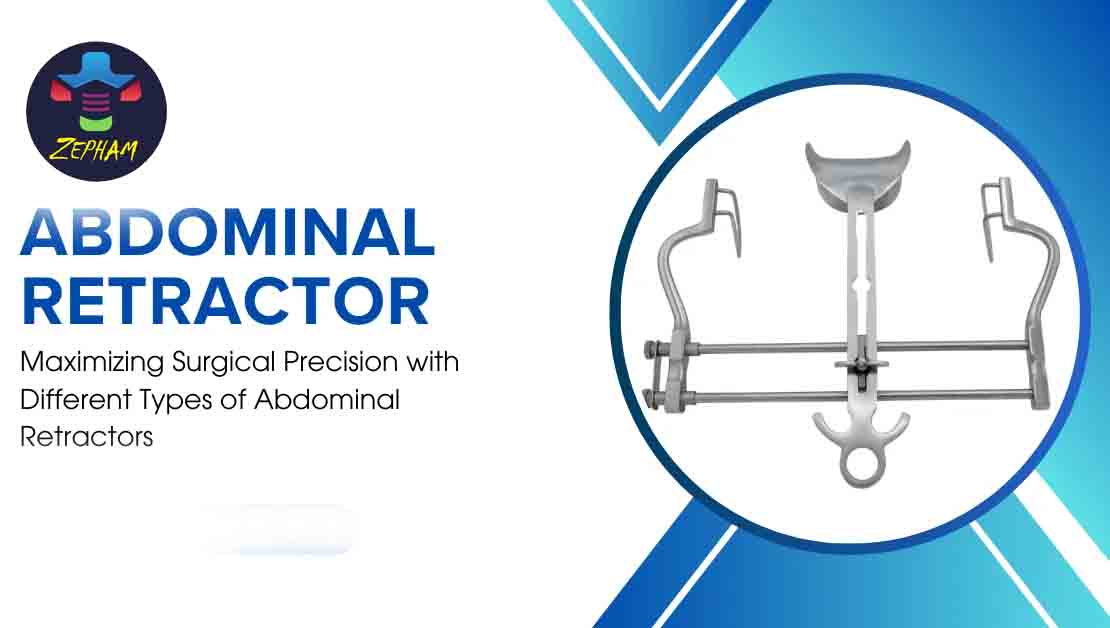Abdominal Retractors for Minimally Invasive Surgeries
An Abdominal Retractor is an amazing instrument used to get better exposure to the abdominal surgical site. During surgical procedures, they help to gently retain back underlying thick tissues, skin, and organs so that medical professionals may get an unconstructive and clear view. They do not damage the nearby area of the skin and tissue; however, they give access to the abdomen cavity while navigating the surgeon to efficiently conduct the surgery.
An Abdominal Retractor is an amazing instrument used to get better exposure to the abdominal surgical site. During surgical procedures, they help to gently retain back underlying thick tissues, skin, and organs so that medical professionals may get an unconstructive and clear view. They do not damage the nearby area of the skin and tissue; however, they give access to the abdomen cavity while navigating the surgeon to efficiently conduct the surgery.
From traditional to advanced abdomen surgeries, abdominal surgical retractors are playing their role skillfully and have become a necessary instrument for surgeons. To understand abdominal retractor types retractor more, let’s learn briefly about the basics.
What are the Abdominal Retractor Types?
In the market, Abdominal Retractor types are designed and created to meet the demands of different surgical scenarios. Mainly, they are divided into two types based on their designs and functions which are explained below.
1. Hand Held Retractors
Hand held retractors come with a dynamic retraction feature. They need manual assistance to hold and manipulate. During surgery, these retractors allow surgeons to reposition the retractor on surgical sites as per the needs of the surgery. They offer flexibility and are highly recommended during procedures where the need for retraction may change suddenly. Moreover, handheld retractors are used while performing treatments that require exact control over the retraction or those involving changeable anatomy.
They are widely used in neurosurgeries, laparotomies, orthopedic, plastic, cardiovascular, and general surgeries.
2. Self Retaining Retractors
Self Retaining Retractors require no manual assistance. On the other hand, they maintain their position while allowing surgeons to get stable exposure. Such retractors are considered the best for long surgical procedures where surgeons need both hands free. Because of their ability, they free up the surgeon and prevent the fatigue of holding and adjusting the retractor.
Generally, they help with abdominal surgery, plastic surgery, neurosurgery, gynecological surgery, thoracic surgery, and cardiovascular and ENT surgeries.
What is the purpose of the abdominal retractor?
Abdominal retractors, whether they are handheld or self-retaining, are essential for establishing a favorable operative environment, which enhances the efficacy and security of abdominal procedures. The prime purpose of abdominal surgical retractors is to support accurate and regulated procedures by preserving visibility and giving the surgeon ease. By using them, the surgeon may be guaranteed that they can precisely navigate and work within the abdominal cavity, protecting surrounding tissues and improving hemostasis.
What Abdominal Retractor Types Are Used in Abdominal Surgery?
Abdominal Self Retaining Retractors and Hand Held Retractors are both used by surgeons during abdominal surgical procedures. The surgeon’s preferences and the type of surgery being performed determine which retractor is best for the surgery. Usually, for the best exposure and access during abdominal procedures, a mix of retractors may be employed. The following are the most popular abdominal surgical retractors.
- Balfour Retractor: It is a handheld retractor that comes with three blades, with a central and two lateral blades. Mostly, it is used in laparotomy procedures including hernia repair, abdominal organ resection, pelvic surgery, bowel surgery, etc. due to its deep and shallow blades.
- O’Sullivan-O’Connor Abdominal Retractor: It is one of the self-retaining retractors for abdominal surgery. It has wingnuts and blades to hold back thick tissues and skin during midline incisions, hysterectomies, appendectomies, hernia repair, and other abdominal procedures.
- Richardson-Eastman Retractor: This retractor is handheld and a variant of the Richardson Retractor. Its right angle and double ends are employed to retain tissues at the surface.
- Deaver Retractor: It is a large handheld retractor that comes with a broad and flat blade. It is best for retracting the abdominal wall during thoracic and abdominal procedures.
- Weitlaner Retractor: It is also one of the self-retaining retractors for abdominal surgery. It has three or four prongs for retraction. Mostly, it is used in herniotomy, saphenous vein graft, femoropopliteal, etc.
- Ribbon Retractor: It is a handheld retractor that comes with ribbon-like blades that help in abdominal surgeries. Its malleable structure allows it to be fitted well in the area. This amazing surgical instrument helps retract the intestine.
- Gelpi Retractor: It is also one of the self-retaining retractors for abdominal surgery with sharp and pointed blades. Due to its unique shape, it is widely used to retract deep and bulky tissues and those tissues that are hard to access during appendectomy, hernia repair, cholecystectomy, and other abdominal vascular procedures.
- Farebeuf Retractor: It is a handheld retractor that comes with one longer and one narrower blade. It is employed in gastrointestinal procedures, urological procedures, abdominal wall procedures, and pelvic surgeries.
How to Enhance Abdominal Retractors’ Life?
All abdominal surgical retractors are reusable and neither harsh environmental changes nor heat and pressure affect the body. But with some extra careful behavior towards retractors may help enhance their lifespan and effectiveness. Let’s read about them.
- After every usage, give the retractors a thorough cleaning with warm water and a light detergent. Ensure that every moving component has been thoroughly cleaned.
- To destroy possible germs, sterilize with the autoclaving method.
- Regularly inspect the retractors for corrosion, wear, and other issues. Replace worn or damaged parts immediately.
- Lubricate hinges and moving parts with an appropriate medical-grade lubricant to ensure the smooth function of the instrument.
- Keep in a dry, clean atmosphere. Always use trays or containers during transit or storage that are intended for that purpose.
- Follow the maintenance and care instructions provided by the manufacturer. Follow the suggested cleaning supplies and sterilizing techniques. Healthcare providers can enroll them in quality assurance programs.
Retractors require effective measures to ensure longevity. Damages caused by incorrect assembling and usage can be avoided by conducting personal training sessions. Moreover, if you find any flaws during.
What should be done if an abdominal retractor is damaged?
An abdominal retractor that is damaged needs to be separated immediately to avoid any potential problems during surgery. Depending on how damaged it is, the retractor should either be replaced or sent for repair. It is suggested to adhere to the policies of the healthcare department on the handling of damaged surgical instruments. That might include notifying the appropriate authorities of the problem, getting a replacement, or setting up permitted repairs to ensure the patient’s safety.
Choose accuracy over quality! Improve the quality of your surgical experience with Surgical Mart’s state-of-the-art Abdominal Surgical Retractors. Get in touch with us right now to discover a world of surgical Instruments innovation and excellence.




